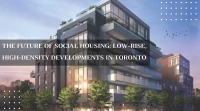The Future of Social Housing: Low-Rise, High-Density Developments in Toronto
Low-rise condos are typically one to nine stories high and offer more units per floor when contrasted with high-rises.
July 30, 2024
Toronto's real estate market is evolving, with a growing focus on low-rise, high-density developments. These projects are becoming increasingly popular as they address critical housing needs while offering several advantages over high-rise counterparts. This blog explores the current state of Toronto's pre-construction market, the benefits of low-rise developments, and why investors should consider these opportunities.
Current State of the Low-Rise Housing Market in Toronto
Toronto's housing market, like much of the Greater Toronto Area (GTA), has experienced significant shifts. As of mid-2024, the city's average home price is $1,173,781, with a slight year-over-year increase of 1.9%. Despite challenges such as high construction costs and fluctuating interest rates, there is a noticeable trend towards the development of low-rise, high-density housing, particularly in the suburbs.
Why Invest in Low-Rise Projects?
-
Affordability and Accessibility Low-rise developments, including semi-detached homes, row houses, and multiplexes, often provide more affordable housing options compared to high-rise condos. These homes are particularly attractive to first-time buyers and families looking for more space without leaving the urban environment.
-
Government Support and Policy Changes Various levels of government in Toronto have introduced policies to support the "missing middle" housing types. Initiatives such as laneway suites, garden suites, and multiplex conversions have been implemented to increase housing density without the need for high-rise buildings. These policies make it easier for developers to pursue low-rise projects, ensuring a steady supply of new homes.
-
Resilience in Market Fluctuations Low-rise housing tends to be more resilient during market fluctuations. With the expected slight increase in ground-oriented housing starts from 2024 to 2026, these projects are poised to respond quickly to changing mortgage rates and market demands.
-
Investment Returns Investors are increasingly interested in low-rise developments due to their higher rental yields and potential for appreciation. As interest rates stabilize and potentially decrease, the demand for rental properties is likely to rise, ensuring steady rental income and capital growth.
-
Community and Quality of Life Low-rise, high-density developments contribute to building vibrant communities. These projects often integrate green spaces, local amenities, and walkable neighborhoods, enhancing the quality of life for residents and fostering a sense of community.
The Outlook for Low-Rise Developments
The forecast for the low-rise market in Toronto looks promising. With a gradual decrease in mortgage rates and strong population growth, there is a positive outlook for these developments. The focus on affordability and sustainability aligns with the broader goals of urban planning and housing policies in Toronto.
Conclusion
Low-rise, high-density developments represent the future of social housing in Toronto. They offer a balanced approach to urban living, providing affordability, resilience, and a high quality of life. For investors, these projects present a unique opportunity to capitalize on the growing demand for sustainable and community-oriented housing solutions. As Toronto continues to evolve, low-rise developments will play a crucial role in shaping the city's housing landscape.
Gallery
Projects Mentioned

Stephen Crowley

Stephen Crowley


